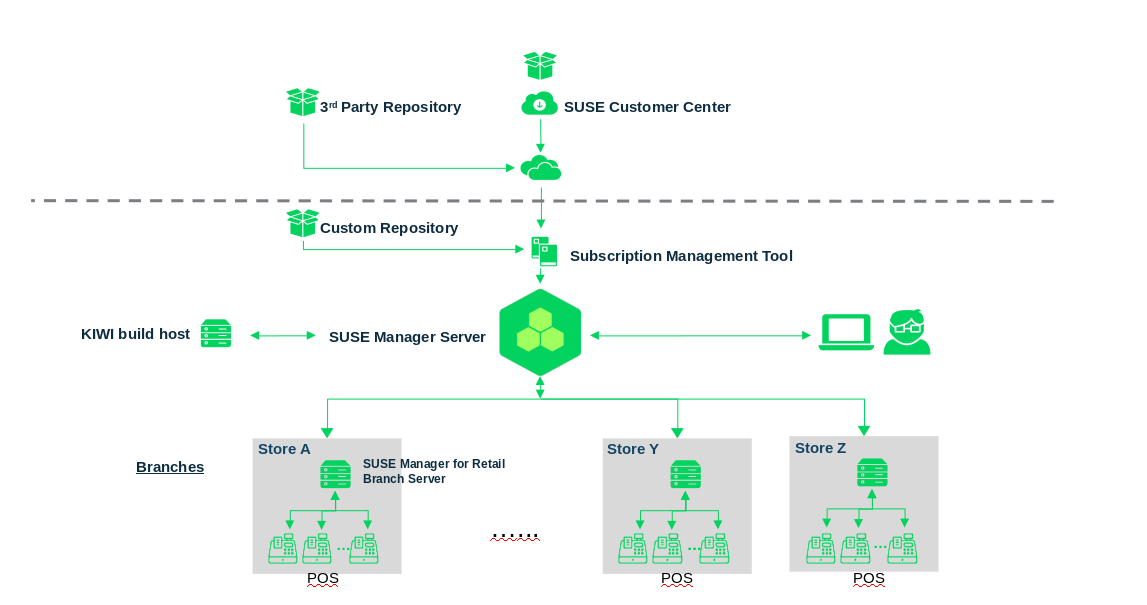Components
SUSE Manager for Retail uses a layered architecture:
-
The first layer contains the SUSE Manager server and one or more build hosts.
-
The second layer contains one or more branch servers to provide local network and boot services.
-
The final layer contains any number of deployed point-of-service terminals.

SUSE Manager Server
The SUSE Manager server contains information about infrastructure, network topology, and everything required to automate image deployment and perform day-to-day operations on branches and terminals. This can include database entries of registered systems, Salt pillar data for images, image assignments, partitioning, network setup, network services, and more.
Build Hosts
Build hosts can be arbitrary servers or virtual machines. They are used to securely build operating system images. Build hosts should be based on SUSE Linux Enterprise Server 12 SP3 or SP4.
Branch Server
Branch servers should be physically located close to point-of-service terminals, such as in an individual store or branch office. We recommend you have a fast network connection between the branch server and its terminals. Branch servers provide services for PXE boot, and act as an image cache, Salt broker, and proxy for software components (RPM packages). The branch server can also manage local networking, and provide DHCP and DNS services.
The branch server can operate in several different network configurations:
-
The branch server has a dedicated network interface card and terminals use an isolated internal branch network. In this configuration, the branch server manages the internal network and provides DHCP, DNS, PXE, FTP, and TFTP services.
-
The branch server shares a network with the terminals, and provides a connection to the SUSE Manager server. In this configuration, the branch server is not required to manage a network (DHCP and DNS services), but acts as a PXE boot server and provides FTP and TFTP services.
Point-of-Service Terminals
Point-of-Service (PoS) terminals can come in many different formats, such as point-of-sale terminals, kiosks, digital scales, self-service systems, and reverse-vending systems. Every terminal, however, is provided by a vendor, who set basic information about the device in the firmware. SUSE Manager for Retail accesses this vendor information to determine how best to work with the terminal in use.
In most cases, different terminals will require a different operating system (OS) image to ensure they work correctly. For example, an information kiosk has a high-resolution touchscreen, where a cashier terminal might only have a very basic display. While both of these terminals require similar processing and network functionality, they will require different OS images. The OS images ensure that the different display mechanisms work correctly.
The minimum memory requirement is 1 GB for hosts that need to run OS images built with Kiwi (PXE booted or not).
Hardware Requirements for PoS Terminals: . At least 1 GB of RAM. For more information, see the documentation of the underlying system (in this case: SUSE Linux Enterprise Server 12). . Disk space depending on the image size.
For more information on SUSE Manager for Retail PoS terminals, see documentation on SUSE Manager Salt clients ().
SUSE Manager for Retail supports PoS terminals that boot using both BIOS and UEFI. For UEFI booting terminals, you will need to configure the EFI partition in the Saltboot formula. For more information on EFI in the Saltboot formula, see retail:retail-formula-saltboot.adoc.
Fitting It All Together
SUSE Manager for Retail uses the same technology as SUSE Manager, but is customized to address the needs of retail organizations.
Hardware Types
Because every environment is different, and can contain many different configurations of many different terminals, SUSE Manager for Retail uses hardware types to simplify device management.
Hardware types allow you to group devices according to manufacturer and device name. Then all devices of a particular type can be managed as one.
Salt Formulas
SUSE Manager for Retail uses Salt formulas to help simplify configuration. Formulas are pre-written Salt states, that are used to configure your installation.
You can use formulas to apply configuration patterns to your hardware groups. SUSE Manager for Retail uses the Saltboot formula, which defines partitioning and OS images for terminals.
You can use default settings for formulas, or edit them to make them more specific to your environment.
System groups
SUSE Manager for Retail uses system groups to organize the various devices in your environment.
Each branch requires a system group, containing a single branch server, and the PoS terminals associated with that server. Each system group is identified with a Branch ID. The Branch ID is used in formulas and scripts to automatically update the entire group.